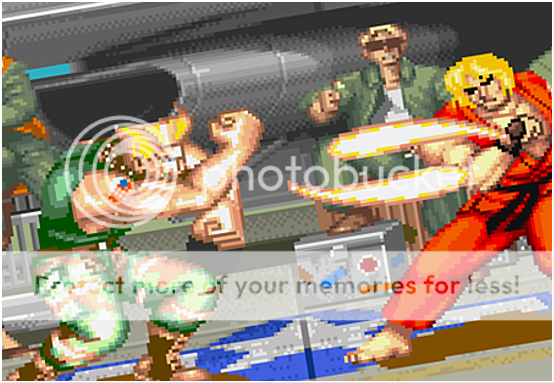"These corporate, corporeal entities [...] shall produce tiny effigies of the deplorable set and create new terms to advance their influence: 'doll' shall be considered weak and unmarketable and girly, and so they shall be termed: 'action figures.' And these action-figures shall enter the susceptible psyches of impressionable and foolish persons by virtue of lustful moving displays of cunning and precocity. The children shall see, and shall want, and shall set upon the adults; and the adults shall rue, and surrender. And the beast will thus be fed."
We're all familiar with Street Fighter II. There's little that hasn't been said about the game that revolutionized multiplayer gaming and shaped the future of the worldwide arcade scene. With its easy-to-learn but tough-to-master controls, lush, colorful graphics, and a groundbreaking cast of selectable characters, SF II virtually created a genre unto itself and became an instant phenomenon both in North America and abroad.
Still, it's easy to forget just how big this game actually was outside the arcades.

Not since Pac-Man had an arcade property exploded onto the pop culture spectrum with such blunt force, casting a lovely array of shrapnel across multiple mediums.
Two animated television series (one produced for the American market and another for Japan), an array of arcade updates (Championship Edition, Turbo, Super, Super Turbo), phenomenally popular ports for the Super NES and SEGA Genesis (but also for Amstrad CPC, Commodore 64, ZX Spectrum, Atari ST and, would you believe it, Gameboy), a Jean-Claude Van Damme action vehicle featuring Raul Julia and Kylie Minogue —
— and the requisite number of collectible tokens, pogs, and foodstuffs. And one long incomplete sentence. And another one.
And, let's not forget, action figures.

The Capcom Street Fighter II figures came to market as a subline of the G.I. Joe toy property, not a bad idea in and of itself.
The venerable G.I. Joe was going through something of a mid-life crisis at the time, and was looking to diversify. As a result, during the early '90s we got wave after wave of bright new figures pressed into action under different banners: Battleforce 2000, Ninja Force, Eco-Warriors, Star Brigade, and the well-remembered (at least by me) Blast Corps.
By all accounts, though, the Street Fighter II line it was a slipshod endeavor from the beginning.

Mostly assembled with scattered parts from older figures (for instance, Ken was basically just a new head atop an old mold for 1992's Storm Shadow), the wild and woolly Street Fighter II characters were hastily put together and looked about as accurate as you'd expect from a toy line made famous for its exacting standardized proportions and svelte interchangeable crotches.
Still, kids gobbled them up, thanks in large part to commercials that made the line look like the biggest thing to hit your neighborhood since the great nor'easter of '89.
Shifty manufacturing practices aside, Hasbro knew a hot property when they saw it, and marketed accordingly. Half a cup of cheesy dialogue, a few tablespoons of electric guitar, a couple of flying plastic vehicles, and a pinch of ethnic stereotyping ("You know 'em, you love 'em — SO CORRECT EM!"), and the G.I. Joe Street Fighters were well on their way to success.

If we're justified in placing our trust in large corporations, then links to YouTube videos will still work just dandy, even if you're reading this in 2047 and the human/mutant hybrid sitting next to you on the rubble pile is hogging the Wi-Fi. So click here to see the commercials. Or here. Or here.
I'm hedging my bets.
Wow! Those commericals brought back memories!
ReplyDeleteStreet Fighter will always live on.
ReplyDelete